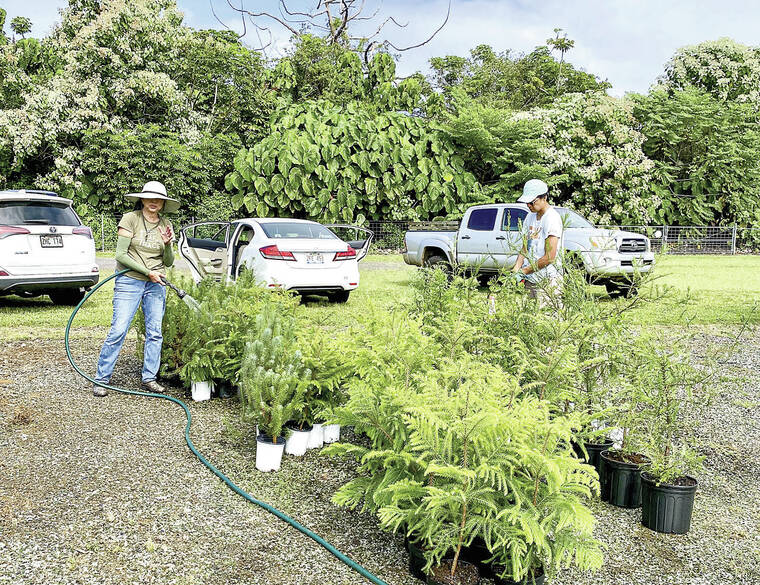Big Island-grown Christmas tree project nears its close

COURTESY PHOTO
Aileen Yeh, contracted by the Hawaii Forest Institute to grow Christmas trees, and Justine Kamelamela, with the Keaukaha-Pana‘ewa Farmers Association, prepare trees for the Black Friday weekend sales at the Pana‘ewa Farmers Market in Hilo.
Locally grown Christmas trees will likely be available for many holidays to come on Hawaii island, even as one project to grow the trees winds down.
The Hawaii Forest Industry Association has conducted the ‘Aina Mauna Christmas Tree Demonstration Project since 2014, planing stands of various Christmasy coniferous species throughout the Big Island to determine whether a sustainable local holiday tree industry is feasible.
The verdict?
“We haven’t crunched all the numbers yet to determine the feasibility,” said Aspen Billiet, project support specialist. “But I think there’s been a slow shift in interest for locally grown trees over the years.”
With a two-year state Department of Agriculture grant expiring at the end of this year, the project is ending soon, Billiet said. She said HFIA has about 500 trees of various ages and species left at nurseries around the island, which she hopes can be sold off over the next year or so.
“If I were in charge, I would like to see HFIA seek a small grant to keep growing what we have and sell off the remainder from the two-year grant,” Billiet said.
Don't miss out on what's happening!
Stay in touch with breaking news, as it happens, conveniently in your email inbox. It's FREE!
The project maintains several stands of trees on the island. One of the most accessible is on Mana Road on Mauna Kea, although the trees grown there are far too large to be suitable for a Christmas tree. Instead, those stands indicate which species are most ideal for Big Island climates and are sources of seeds for dedicated tree farms.
Billiet said most of the species the project worked with grew fairly well, and particularly pointed out resilient species like Italian stone pine and Norfolk pine, although she acknowledged they don’t quite match the conical shape of the archetypal Christmas tree.
Sequoia, meanwhile, is one of the fastest-growing trees demonstrated in the project, which Billiet said could serve as a picturesque decoration during the holidays before being transplanted to a more permanent outdoor location.
Local trees like alahee can be a suitable alternative “if you’re open-minded,” Billiet said.
Billiet said the final phase of the project, funded by the DOA grant, worked with Big Island nurseries to grow certain selected species. Potted trees could be sold to individuals or to farms that would continue to grow them until they’re at harvest age.
However, she said, only one farm bought a crop of trees: Rebels’ Roost Farm and Apiary near Hilo.
Rebels’ Roost co-owner Kelli Bolger said the HFIA trees aren’t the only Christmas trees she is trying to raise on her farm, having sourced several pine and cypress saplings from elsewhere on the island.
“We definitely think it’s viable or we wouldn’t be doing it,” Bolger said. “I think there’s been an increase in awareness of the impact of importing big loads of trees from the mainland.”
A 2012 study by the Department of Land and Natural Resources estimated that 190,000 trees are sold in Hawaii each holiday season, 96% of which are imported. However, the DLNR and some environmental groups have repeatedly warned that imported trees are potential vectors for invasive species to reach Hawaii, and in 2019 an alligator lizard was able to travel from Washington state to Hilo by stowing away on a tree.
Bolger added that the susceptibility of tree farms in the Pacific Northwest to wildfires has increased interest in tree sources closer to home.
While none of Bolger’s trees, whether from HFIA or elsewhere, are ready to be harvested, she believes the ritual of taking the family to a tree farm, picking out a tree together and cutting it down will be an attractive experience that will keep local tree farms alive on the island.
“It’s just a nice annual family tradition that I think people will want to do every year,” Bolger said.



